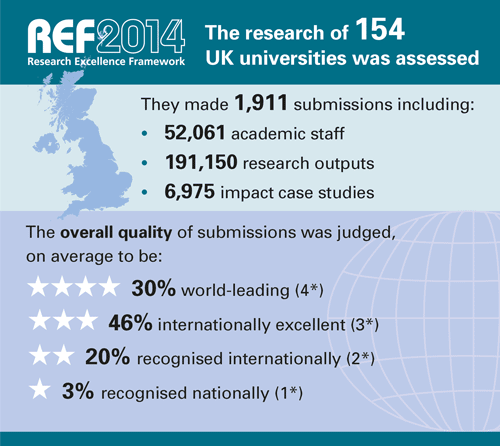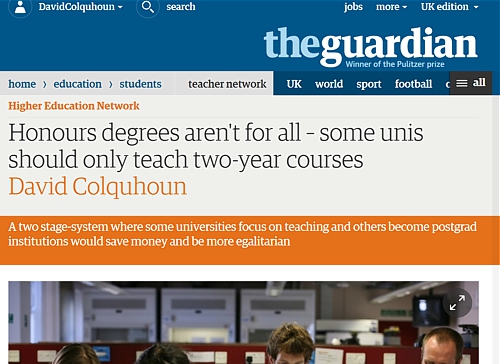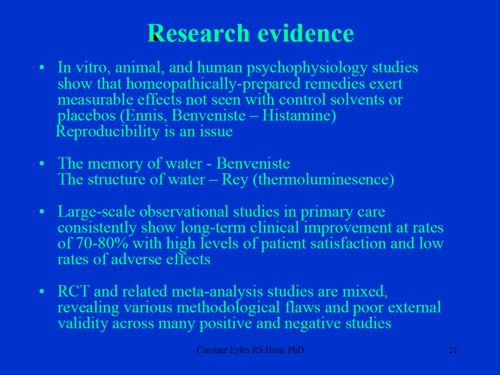Education
DOI: 10.15200/winn.142809.94999
The Research Excellence Framework (REF) is the latest in a series of 6-yearly attempts to assess the quality of research in UK universities. It’s used to decide how to allocate about £1.6 billion per year of taxpayers’ money, the so-called "quality-related" (QR) allocation.
It could have been done a lot worse. One of the best ideas was that only four papers could be submitted, whatever the size of a research group. After much argument, the judgment panels were told not to use journal impact factors as a proxy for quality (or, for lack of quality), though it’s clear that many people did not believe that this would be obeyed, But it cost at least £60 million. At UCL alone, it took 50 – 75 person-years of work. and the papers that were submitted were assessed by people who often would have no deep knowledge about the field, It was a shocking waste of time and money, and its judgements in the end were much the same as last time.
Did the REF benefit science?
It’s frequently said that the REF improved the UK’s science output. The people who claim this need a course in the critical assessment of evidence. Firstly, there is no reason to think that science has improved in quality in the last 6 years, and secondly any changes that might have occurred are hopelessly confounded with the passage of time, the richest source of false correlations.
I’d argue that the REF has harmed science by encouraging the perverse incentives that have done so much to corrupt academia. The REF, and all the other university rankings produced by journalists, are taken far too seriously by vice-chancellors and that does active harm. As one academic put it
"This isn’t about science – it’s about bragging rights, or institutional willy-waving. "
There are now serious worries about lack of reproducibility of published work, waste of money spent on unreliable studies, publication of too many small under-powered studies, bad statistical practice (like ignoring the false discovery rate), and about exaggerated claims by journals, university PR people and authors themselves. These result in no small part from the culture of metrics and the mismeasurement of science. The REF has added to the pressures.
It is highly unsatisfactory, so the only real question becomes what should be done instead?
What’s to be done?
Transferring all the QR money to Research Councils won’t work. It would merely encourage the grossly bad behaviour that we’ve seen at Imperial College London, Warwick University, Kings College London and Queen Mary College London, all of whom have fired successful senior staff simple because their grant income wasn’t deemed big enough. (This is odd because the same managers whine continually that they make a loss on research grants, but that’s another question.) It’s been suggested that this could be avoided by reducing considerably the overheads that come with grants, but this would leave a shortfall that, without QR, would be impossible to make up.
At present a HEFCE working group is considering the possibility that metrics might be used in the next REF. It’s a sensible group of people, and they are well aware of the corrupting influence of metrics, and the lack of evidence that they measure the quality of research. So if reading papers takes too much time and money, and metrics are likely to lead to widespread "gaming" (a euphemism for cheating), what should be done?
I made a suggestion in 2010, but it seems to have been totally ignored, despite appearing in the Times (in their premier
Thunderer opinion column. So I’ll try to make the case again, in the context of the REF.
A complete re-thinking of tertiary education is needed,
Proposal for a two stage higher education system
It seems to be a good thing that such a large proportion of the population now get higher education. But the university system has failed to change to cope with the huge increase in the number of students.
The system of highly specialist honours degrees might have been adequate when 5% of the population did degrees, but that system seems quite inappropriate when 50% are doing them.
There are barely enough university teachers who are qualified to teach specialist 3rd year or postgraduate courses. And many teachers must have suffered from (in my field) trying to teach the subtleties of the exponential probability density function to a huge third year class, most of whom have already decided that they want to be bankers or estate agents.
These considerations have driven me to conclude, somewhat reluctantly, that the whole system needs to be altered.
Honours degrees were intended as a prelude to research and 50% of the population are not going to do research (fortunately for the economy). Vice-chancellors have insisted on imposing on large numbers of undergraduates, highly specialist degrees which are not what they want or need.
I believe that all first degrees should be ordinary degrees, and these should be less specialist than now. Some institutions would specialise in teaching such degrees, others would become predominantly postgraduate institutions, which would have the time. money and expertise to do proper advanced teaching, rather than the advanced Powerpoint courses that dominate what passes for Graduate Schools in the UK.
There would, of course, be almighty rows about which universities would be re-allocated to teach ordinary degrees. That’s not a reason to educate students in 2015 using a pre-war system.
The two-stage system would be more egalitarian than the present one
I anticipate that some people might think that this system is a reversion to the pre-1992 divide between polytechnics and universities. It isn’t. The pre-1992 system labelled you as either polytechnic or university: it was a two-tier system. I’m proposing a two stage system. The two sorts of institution work in series, not in parallel.
Such a system would be more egalitarian than now, not less.
Everyone would start out with the same broad undergraduate education, and the decision about whether to specialise, and the area in which to specialise, would not have to be made before leaving (high) school, as now, but would be postponed until two or three years later. That’s a lot better, especially for people from poorer backgrounds.
If this were done, most research would be done in the postgraduate institutions. Of course there are some good researchers in institutions that would become essentially teaching-only, so there would have to be chances for such people to move to postgraduate universities, and for some people to move in the other direction.
This procedure would, no doubt, result in a reduction in the huge number of papers that are published (but read by nobody). That is another advantage of my proposal. It’s commonly believed that there is a large amount of research that is either trivial or wrong. In biomedical research, it’s been estimated that 85% of resources are wasted (Macleod et al., 2014).
It’s well-known that any paper, however bad, can be published in a peer-reviewed journal. Pubmed, amazingly, indexes something like 30 jouranls devoted to quack medicine, in which papers by quacks are peer-reviewed by other quacks, and which are then solemnly counted by bean-counters as though they were real research. The pressure to publish when you have nothing to say is one of the perverse incentives of the metrics culture.
It seems likely that standards of research in second-stage universities would be at least as high as at present. It that’s the case then QR could simply be allocated on the basis of the number of people in a department. Dorothy Bishop has shown that even under the present system, the amount of QR money received is strongly correlated with the size of the department (correlation coefficient = 0.995 for psychology/neuroscience).
From Dorothy Bishop’s blog. r = 0.995
Using metrics produces only a tiny increase in the correlation coefficient for RAE data. It could hardly be any higher than 0.995
In other words, after all the huge amount of time, effort and money that’s been put into assessment of research, every submitted researcher ends up getting much the same amount of money.
That system wouldn’t work at the moment, because, sadly, universities would, no doubt, submit the departmental cat for a share of the cash. But it could work under a system such as I’ve described. The allocation of QR would take microseconds and cost nothing.
How much would the two-stage system cost?
To have any hope of being accepted by politicians, the two-stage system would probably have to cost no more than the existing system. As far as I know. nobody seems to have made any serious attempt to work out the costs. Perhaps they should. It won’t be easy because an important element of the two-stage system is to improve postgraduate education, and postgraduate education was forgotten in the government’s "reforms"
Much would depend on whether the first stage, ordinary degrees could be taught in two years. In an institution that does little research, there would be no justification for the long summer vacation. Something comparable with (high) school holidays would be more appropriate, and if a decent job could be done in two years, that could save enough money to pay for the rest. It would also mimimise the debt that hangs round the neck of graduates.
The cost of running the second stage would depend on how many students opted (and qualified) to carry on to do an honours degree, and on how many of those wanted go on to graduate school and higher degrees. The numbers of people that went on to specialist honours degrees would inevitably be smaller than now, so their education would be cheaper. But, crucially, they could be educated better. And because of the specialist researchers in a postgraduate institution, it would be possible to have real postgraduate education in advanced research methods,
At present, Graduate Schools in the UK (unlike those in the USA) rarely teach topics beyond advanced Powerpoint, and that’s a recipe for later mediocrity.
In order to estimate the actual cost, we’d need to know how many people wanted to go beyond the first degree (and qualified to do so). If this were not to large, the proposed system could well be cheaper than the presnet one, as well as being more egalitarian, and providing better postgraduate education. The Treasury should like that.
The California System
It will not have escaped the readers’ attention that the two stage system proposed here has much in common with higher education in the USA. In particular, it resembles the University of California system, which was started in 1960. It became a model for the rest of the world.
Meanwhile, the UK persists with a pre-war system of specialist honours degrees that is essentially unchanged since only a handful of people went to universities.
It’s time for the UK to have a serious debate about whether we need to change.
Follow-up
I just noticed this, from the inimitable Laurie Taylor. It is dated 4 July 2013. Who says the REF does not encourage cheating?
AppointmentsAre you a distinguished academic researcher looking to supplement your income? Then look no further. Poppleton is offering 24 extraordinarily well-paid and extraordinarily part-time posts to leading scholars in almost any discipline who will help to raise its profile in the research excellence framework. These posts will follow what is known as the Cardiff-Swansea paradigm in that successful candidates need not have conducted any of their distinguished research at Poppleton, have no need to ever visit the actual campus, and can be assured that their part-time contracts will expire immediately after the date of the REF census. Please apply marking your application “REF FARCE”. |
3 February 2015
The day after this post appeared the Guardian published a version of it which discussed only the two-stage degree proposals but omits the bit about the Research Excellence Framework (REF 2014). The title was "Honours degrees aren’t for all – some unis should only teach two-year courses". There are a lot more comments there than than here.. I assume that the headline was written by one of those pesky subeditors who failed to understand what’s important (the two year degrees were just a suggestion, nothing to do with the main proposals).
3 April 2015
As an experiment, this blog has been re-posted on the Winnower. The advantage of this is that it now has a digital object identifier, DOI: 10.15200/winn.142809.94999
Almost all the revelations about what’s taught on university courses in alternative medicine have come from post-1992 universities. (For readers not in the UK, post-1992 universities are the many new univerities created in 1992, from former polytechnics etc, and Russell group universities are the "top 20" research-intensive universities)
It is true that all the undergraduate courses are in post-1992 universities, but the advance of quackademia is by no means limited to them. The teaching at St Bartholomew’s Hospital Medical School, one of the oldest, was pretty disgraceful for example, though after protests from their own students, and from me, it is now better, I believe.

Quackery creeps into all universities to varying extents. The good ones (like Southampton) don’t run "BSc" degrees, but it still infiltrates through two main sources,
The first is via their HR departments, which are run by people who tend to be (I quote) "credulous and moronic" when it comes to science.
The other main source is in teaching to medical students. The General Medical Council says that medical students must know something about alterantive medicine and that’s quite right, A lot of their patients will use it. The problem is that the guidance is shockingly vague .
“They must be aware that many patients are interested in and choose to use a range of alternative and complementary therapies. Graduates must be aware of the existence and range of such therapies, why some patients use them, and how these might affect other types of treatment that patients are receiving.” (from Tomorrow’s Doctors, GMC)
In many medical schools, the information that medical students get is quite accurate. At UCL and at King’s (London) I have done some of the familiarisation myself. In other good medical schools, the students get some shocking stuff. St Bartholomew’s Hospital medical School was one example. Edinburgh University was another.
But there is one Russell group university where alternative myths are propagated more than any other that I know about. That is the University of Southampton.
In general, Southampton is a good place, I worked there for three years myself (1972 – 1975). The very first noise spectra I measured were calculated on a PDP computer in their excellent Institute of Sound and Vibration Research, before I wrote my own programs to do it.
But Southanpton also has a The Complementary and Integrated Medicine Research Unit . Oddly the unit’s web site, http://www.cam-research-group.co.uk, is not a university address, and a search of the university’s web site for “Complementary and Integrated Medicine Research Unit” produces no result. Nevertheless the unit is “within the School of Medicine at the University of Southampton”
Notice the usual euphemisms ‘complementary’ and ‘integrated’ in the title: the word ‘alternative’ is never used. This sort of word play is part of the bait and switch approach of alternative medicine.
The unit is quite big: ten research staff, four PhD students and two support staff It is headed by George Lewith.
Teaching about alternative medicine to Southampton medical students.
The whole medical class seems to get quite a lot compared with other places I know about. That’s 250 students (210 on the 5-year course plus another 40 from the 4-year graduate-entry route).
Year 1: Lecture by David Owen on ‘holism’ within the Foundation Course given to all 210 medical students doing the standard (5-year) course.
Year 2: Lecture by Lewith (on complementary medicine, focusing on acupuncture for pain) given within the nervous systems course to the whole medical student year-group (210 students).
Year 3 SBOM (scientific basis of medicine) symposium: The 3-hour session (“Complementary or Alternative Medicine: You Decide”). I’m told that attendance at this symposium is often pretty low, but many do turn up and all of them are officially ‘expected’ to attend.
There is also an optional CAM special study module chosen by 20 students in year 3, but also a small number of medical students (perhaps 2 – 3 each year?) choose to do a BMedSci research project supervised by the CAM research group and involving 16-18 weeks of study from October to May in Year 4. The CAM research group also supervise postgraduate students doing PhD research.
As always, a list of lectures doesn’t tell you much. What we need to know is what’s taught to the students and something about the people who teach it. The other interesting question is how it comes about that alternative medicine has been allowed to become so prominent in a Russell group university. It must have support from on high. In this case it isn’t hard to find out where it comes from. Here are some details.
Year 1 Dr David Owen
David Owen is not part of Lewith’s group, but a member of the Division of Medical Education headed by Dr Faith Hill (of whom, more below). He’s one of the many part-time academics in this area, being also a founder of The Natural Practice .
Owen is an advocate of homeopathy (a past president of the Faculty of Homeopathy). Homeopathy is, of course, the most barmy and discredited of all the popular sorts of alternative medicine. Among those who have discredited it is the head of the alt med unit, George Lewith himself (though oddly he still prescribes it).
And he’s also a member of the British Society of Environmental Medicine (BSEM). That sounds like a very respectable title, but don’t be deceived. It is an organisation that promotes all sorts of seriously fringe ideas. All you have to do is notice that the star speaker at their 2011 conference was none other than used-to-be a doctor, Andrew Wakefield, a man who has been responsible for the death of children from measles by causing an unfounded scare about vaccination on the basis of data that turned out to have been falsified. There is still a letter of support for Wakefield on the BSEM web site.
The BSEM specialises in exaggerated claims about ‘environmental toxins’ and uses phony allergy tests like kinesiology and the Vega test that misdiagnose allergies, but provide en excuse to prescribe expensive but unproven nutritional supplements, or expensive psychobabble like "neuro-linguistic programming".
Other registered "ecological physicians" include the infamous Dr Sarah Myhill, who, in 2010, was the subject of a damning verdict by the GMC, and Southampton’s George Lewith.
If it is wrong to expose medical students to someone who believes that dose-response curves have a negative slope (the smaller the dose the bigger the effect -I know, it’s crazy), then it is downright wicked to expose students to a supporter of Andrew Wakefield.
David Owen’s appearance on Radio Oxford, with the indomitable Andy Lewis appears on his Quackometer blog.
Year 2 Dr George Lewith
Lewith is a mystery wrapped in an enigma. He’s participated in some research that is quite good by the (generally pathetic) standards of the world of alternative medicine.
In 2001 he showed that the Vega test did not work as a method of allergy diagnosis. "Conclusion Electrodermal testing cannot be used to diagnose environmental allergies", published in the BMJ .[download reprint].
In 2003 he published "A randomized, double-blind, placebo-controlled proving trial of Belladonna 30C” [download reprint] that showed homeopathic pills with no active ingredients had no effects: The conclusion was "”Ultramolecular homeopathy has no observable clinical effects" (the word ultramolecular, in this context, means that the belladonna pills contained no belladonna).
In 2010 he again concluded that homeopathic pills were no more than placebos, as described in Despite the spin, Lewith’s paper surely signals the end of homeopathy (again). [download reprint]
What i cannot understand is that, despite his own findings, his private practice continues to prescribe the Vega machine and continues to prescribe homeopathic pills. And he continues to preach this subject to unfortunate medical students.
Lewith is also one of the practitioners recommended by BSEM. He’s a director of the "College of Medicine". And he’s also an advisor to a charity called Yes To Life. (see A thoroughly dangerous charity: YesToLife promotes nonsense cancer treatments).
3rd year Student Selected Unit
The teaching team includes:
- David Owen – Principal Clinical Teaching Fellow SoM, Holistic Physician
- George Lewith – Professor of Health Research and Consultant Physician
- Caroline Eyles – Homeopathic Physician
- Susan Woodhead – Acupuncturist
- Elaine Cooke – Chiropractic Practitioner
- Phine Dahle – Psychotherapist
- Keith Carr – Reiki Master
- Christine Rose – Homeopath and GP
- David Nicolson – Nutritionalist
- Shelley Baker – Aromatherapist
- Cheryl Dunford – Hypnotherapist
- Dedj Leibbrandt – Herbalist
More details of the teaching team here. There is not a single sceptic among them, so the students don’t get a debate, just propaganda.
In this case. there’s no need for the Freedom of Information Act. The handouts. and the powerpoints are on their web site. They seem to be proud of them
Let’s look at some examples
Chiropractic makes an interesting case, because, in the wake of the Singh-BCA libel case, the claims of chiropractors have been scrutinised as never before and most of their claims have turned out to be bogus. There is a close relationship between Lewith’s unit and the Anglo-European Chiropractic College (the 3rd year module includes a visit there). In fact the handout provided for students, Evidence for Chiropractic Care , was written by the College. It’s interesting because it provides no real evidence whatsoever for the effectiveness of chiropractic care. It’s fairly honest in stating that the view at present is that, for low back pain, it isn’t possible to detect any difference between the usefulness of manipulation by a physiotherapist, by an osteopath or by a chiropractor. Of course it does not draw the obvious conclusion that this makes chiropractic and osteopathy entirely redundant -you can get the same result without all the absurd mumbo jumbo that chiropractors and osteopaths love, or their high-pressure salesmanship and superfluous X-rays. Neither does it mention the sad, but entirely possible, outcome that none of the manipulations are effective for low back pain. There is, for example, no mention of the fascinating paper by Artus et al [download reprint]. This paper concludes
"symptoms seem to improve in a similar pattern in clinical trials following a wide
variety of active as well as inactive treatments."
This paper was brought to my attention through the blog run by the exellent physiotherapist, Neil O’Connell. He comments
“If this finding is supported by future studies it might suggest that we can’t even claim victory through the non-specific effects of our interventions such as care, attention and placebo. People enrolled in trials for back pain may improve whatever you do. This is probably explained by the fact that patients enrol in a trial when their pain is at its worst which raises the murky spectre of regression to the mean and the beautiful phenomenon of natural recovery.”
This sort of critical thinking is conspicuously absent from this (and all the other) Southampton handouts. The handout is a superb example of bait and switch: No nonsense about infant colic, innate energy or imaginary subluxations appears in it.
Acupuncture is another interesting case because there is quite a lot of research evidence, in stark contrast to the rest of traditional Chinese medicine, for which there is very little research.
|
There is a powerpoint show by Susan Woodhead (though it is labelled British Acupuncture Council). The message is simple and totally uncritical. It works. |
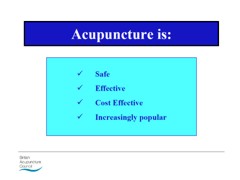
|
In fact there is now a broad consensus about acupuncture.
(1) Real acupuncture and sham acupuncture have been found to be indistinguishable in many trials. This is the case regardless of whether the sham is a retractable needle (or even a toothpick) in the "right" places, or whether it is real needles inserted in the "wrong" places. The latter finding shows clearly that all that stuff about meridians and flow of Qi is sheer hocus pocus. It dates from a pre-scientific age and it was wrong.
(2) A non-blind comparison of acupuncture versus no acupuncture shows an advantage for acupuncture. But the advantage is usually too small to be of any clinical significance. In all probability it is a placebo effect -it’s hard to imagine a more theatrical event than having someone in a white coat stick long needles into you, like a voodoo doll. Sadly, the placebo effect isn’t big enough to be of much use.
Needless to say, none of this is conveyed to the medical students of Southampton. Instead they are shown crude ancient ideas that date from long before anything was known about physiology as though they were actually true. These folks truly live in some alternative universe. Here are some samples from the acupuncture powerpoint show by Susan Woodhead.
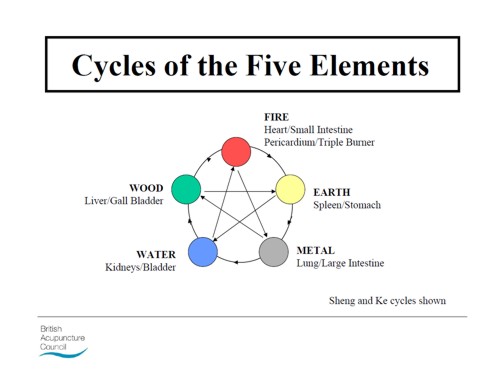

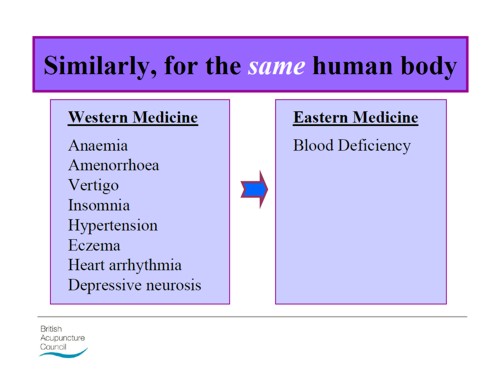
Well this is certainly a "different diagnostic language", but no attempt is made to say which one is right. In the mind of the acupuncurist it seems both are true. It is a characteristic of alternative medicine advocates that they have no difficulty in believing simultaneously several mutually contradictory propositions.
As a final exmple of barminess, just look at the acupuncture points (allegedly) on the ear The fact that it is a favoured by some people in the Pentagon as battlefield acupuncture, is more reminiscent of the mad general, Jack D. Ripper, in Dr Strangelove than it is of science.
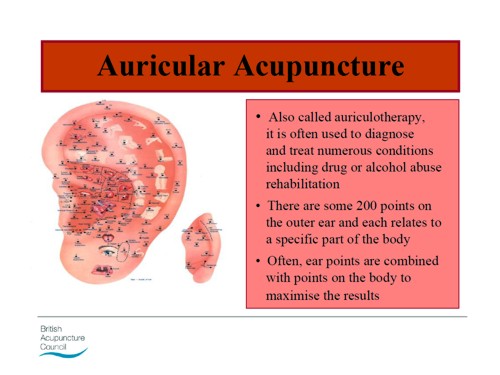
There is an equally uncritical handout on acupuncture by Val Hopwood. It’s dated March 2003, a time before some of the most valuable experiments were done.
The handout says "sham acupuncture
is generally less effective than true acupuncture", precisely the opposite of what’s known now. And there are some bits that give you a good laugh, always helpful in teaching. I like
“There is little doubt that an intact functioning nervous system is required for acupuncture to produce
analgesia or, for that matter, any physiological changes”
and
Modern techniques: These include hybrid techniques such as electro-acupuncture . . . and Ryadoraku [sic] therapy and Vega testing.
Vega testing!! That’s been disproved dozens of times (not least by George Lewith). And actually the other made-up nonsense is spelled Ryodoraku.
It’s true that there is a short paragraph at the end of the handout headed "Scientific evaluation of acupuncture" but it doesn’t cite a single reference and reads more like excuses for why acupuncture so often fails when it’s tested properly.
Homeopathy. Finally a bit about that most boring of topics, the laughable medicine that contains no medicine, homeopathy. Caroline Eyles is a member for the Society of Homeopaths, the organisation that did nothing when its members were caught out in the murderous practice of recommending homeopathy for prevention of malaria. The Society of Homeopaths also endorses Jeremy Sherr, a man so crazy that he believes he can cure AIDS and malaria with sugar pills.
The homeopathy handout given to the students has 367 references, but somehow manages to omit the references to their own boss’s work showing that the pills are placebos. The handout has all the sciencey-sounding words, abused by people who don’t understand them.
"The remedy will be particularly effective if matched to the specific/particular characteristics of the individual (the ‘totality’ of the patient) on all levels, including the emotional and mental levels, as well as just the physical symptoms. ‘Resonance’ with the remedy’s curative power will then be at it’s [sic] best."
The handout is totally misleading about the current state of research. It says
"increasing clinical research confirms it’s [sic] clinical effectiveness in treating patients, including babies and animals (where a placebo effect would be hard to justify)."
|
The powerpont show by Caroline Eyles shows all the insight of a mediaeval vitalist |
|
Anyone who has to rely on the utterly discredited Jacques Benveniste as evidence is clearly clutching at straws. What’s more interesting about this slide the admission that "reproducibility is a problem -oops, an issue" and that RCTs (done largely by homeopaths of course) have "various methodological flaws and poor external validity". You’d think that if that was the best that could be produced after 200 yours, they’d shut up shop and get another job. But, like aging vicars who long since stopped believing in god, but are damned if they’ll give up the nice country rectory, they struggle on, sounding increasingly desperate.
How have topics like this become so embedded in a medical course at a Russell group university?
The details above are a bit tedious and repetitive. It’s already established that hardly any alternative medicine works. Don’t take my word for it. Check the web site of the US National Center for Complementary and Alternative Medicine (NCCAM) who, at a cost of over $2 billion have produced nothing useful.
A rather more interesting question is how a good university like Southampton comes to be exposing its medical students to teaching like this. There must be some powerful allies higher up in the university. In this case it’s pretty obvious who thay are.
Professor Stephen Holgate MD DSc CSc FRCP FRCPath FIBiol FBMS FMed Sci CBE has to be the primary suspect, He’s listed as one of Southampton’s Outstanding Academics. His work is nothing to do with alternative medicine but he’s been a long term supporter of the late unlamented Prince of Wales’ Foundation, and he’s now on the advisory board of it’s successor, the so called "College of Medicine" (for more information about that place see the new “College of Medicine” arising from the ashes of the Prince’s Foundation for Integrated Health, and also Don’t be deceived. The new “College of Medicine” is a fraud and delusion ). His description on that site reads thus.
"Stephen Holgate is MRC Clinical Professor of Immunopharmacology at the University of Southampton School of Medicine and Honorary Consultant Physician at Southampton University Hospital Trust. He is also chair of the MRC’s Populations and Systems Medicine Board. Specialising in respiratory medicine, he is the author of over 800 peer-reviewed papers and contributions to scientific journals and editor of major textbooks on asthma and rhinitis. He is Co-Editor of Clinical and Experimental Allergy, Associate Editor of Clinical Science and on the editorial board of 25 other scientific journals."
Clearly a busy man. Personally I’m deeply suspicious of anyone who claims to be the author of over 800 papers. He graduated in medicine in 1971, so that is an average of over 20 papers a year since then, one every two or three weeks. I’d have trouble reading that many, never mind writing them.
Holgate’s long-standing interest in alternative medicine is baffling. He’s published on the topic with George Lewith, who, incidentally, is one of the directors of the "College of Medicine"..
It may be unkind to mention that, for many years now, I’ve been hearing rumours that Holgate is suffering from an unusually bad case of Knight starvation.
The Division of Medical Education appears to be the other big source of support for. anti-scientific medicine. That is very odd, I know, but it was also the medical education people who were responsible for mis-educating medical students at. St. Bartholomew’s and at Edinburgh university. Southampton’s Division of Medical Education has a mind-boggling 60 academic and support staff. Two of them are of particular interest here.
Faith Hill is director of the division. Her profile doesn’t say anything about alternative medicine, but her interest is clear from a 2003 paper, Complementary and alternative medicine: the next generation of health promotion?. The research consisted of reporting anecdotes from interviews of 52 unnamed people (this sort of thing seems to pass for research in the social sciences). It starts badly by misrepresenting the conclusions of the House of Lords report (2000) on CAM. Although it comes to no useful conclusions, it certainly shows a high tolerance of nonsensical treatments.
Chris Stephens is Associate Dean of Medical Education & Student Experience. His sympathy is shown by a paper he wrote In 2001, with David Owen (the homeopath, above) and George Lewith: Can doctors respond to patients’ increasing interest in complementary and alternative medicine?. Two of the conclusions of this paper were as follows.
"Doctors are training in complementary and alternative medicine and report benefits both for their patients and themselves"
Well, no actually. It wasn’t true then, and it’s probably even less true now. There’s now a lot more evidence and most of it shows alternative medicine doesn’t work.
"Doctors need to address training in and practice of complementary and alternative medicine within their own organisations"
Yes they certainly need to do that.
And the first thing that Drs Hill and Stephens should do is look a bit more closely about what’s taught in their own university, I hope that this post helps them,
Follow-up
4 July 2011. A correspondent has just pointed out that Chris Stephens is a member of the General Chiropractic Council. The GCC is a truly pathetic pseudo-regulator. In the wake of the Simon Singh affair it has been kept busy fending off well-justified complaints against untrue claims made by chiropractors. The GCC is a sad joke, but it’s even sadder to see a Dean of Medical Education at the University of Southampton being involved with an organisation that has treated little matters of truth with such disdain.
A rather unkind tweet from (ex)-chiropractor @RichardLanigan.
“Chris is just another light weight academic who likes being on committees. Regulatory bodies are full of them”
This is the third part of a series of guest posts on the curious Steiner Waldorf cult
The first part was The true nature of Steiner (Waldorf) education. Mystical barmpottery at taxpayers’ expense. Part 1
Part 2 was The Steiner Waldorf cult uses bait and switch to get state funding. Part 2
This post deals with the most contentious and serious aspect of Steiner schools, racism. It makes, in my view, a convincing argument that Steiner’s undoubtedly racist views remain a problem today. They can’t be dismissed simply by saying that Steiner was a child of his times.
This post was written by an ex-Steiner school parent, known on the web as @ThetisMercurio.
The essay supplies yet more reasons to think that Steiner schools are all based on pseudo science: Steiner’s Spiritual Science. It is important that we understand these schools because funding of these schools is imminent, through Michael Gove’s Free Schools policy.
Extracts from works by Olav Hammer and Peter Staudenmaier are included with the permission of the authors.
A Spiritual Elite
Our first two posts introduced Anthroposophy and our concerns about the state funding of Steiner Waldorf schools through the Free Schools policy. Anthroposophy, the belief system developed by Rudolf Steiner, undeniably underpins the pedagogy which informs teaching practice in Steiner schools. This is reflected in the course materials and recommended texts for Steiner trainee teachers, wherever these have been obtained.
|
What must be stressed is that an adherence to Anthroposophy and aspects of this pedagogy can lead teachers to make decisions about individual children based on race and disability, which many people would consider to be outright discrimination.
|
 Ceiling, First Goetheanum, Rudolf Steiner. Spirit worlds. |
This discrimination may be undeclared and subtle but we believe it is, when rightly understood, within the comprehension and scope of the Equality Act 2010 as interpreted by the Equality and Human Rights Commission. Does the ideological drive towards Free Schools justify a breach in the rights of children not to be exposed to such potentially damaging practice?
In this post I write about the history of Anthroposophy, and how Steiner’s privileged status amongst adherents has obscured understanding of Steiner Waldorf education. Although I’ll focus on Steiner’s race doctrines, it’s important to understand that an anthroposophical belief in karma and reincarnation must have an impact on children with learning disabilities. Some of the most distressing personal accounts on parent forums have described an encounter with this particular aspect of Steiner’s dogma. Liz Ditz, a writer on education and learning disabilities, has the same concern with regard to Waldorf Charters in the US:
“Waldorf/Steiner [is] particularly pernicious for children with educational special needs such as dyslexia, ADHD, and autism. Because of the underlying beliefs in karma and reincarnation, teachers at Waldorf/Steiner tend to believe that such educational challenges are part of a child’s destiny to “work out”. The Waldorf/Steiner attitude does not satisfy US laws relative to educating students.”
Roger Rawlings indicates Steiner’s thinking on disability on Waldorf Watch and the UK site EASE online has an account of ‘karma in the classroom’ by a parent with a Steiner training. Swedish blogger Alicia Hamberg describes the University of Aberdeen’s programme on Rudolf Steiner’s curative pedagogy, which draws directly on Steiner’s clairvoyantly acquired ideas. This area demands greater investigation before English Steiner schools can be assumed to satisfy discrimination legislation regarding children with disabilities.
There is a determined lack of interest and comprehension about the nature of Anthroposophy amongst those responsible for overseeing the inspection of Steiner schools (Ofsted, which delegates to the SIS) and also amongst those who will make the decision to fund particular schools. It may appear too difficult. The structure of an esoteric belief system, with gradually imparted ‘knowledge’: impenetrable texts, study groups, a tradition of communicating certain information orally (a great deal isn’t written down) and a distrust of critical thinking, means that Steiner teachers themselves can be confused about the nature or real life implications of Steiner’s dogma, as well as largely ignorant of the Waldorf movement’s history. But there is an undeclared hierarchy of anthroposophical knowledge and influence within a Steiner school’s college of teachers; decisions about individual children are often steered by collegiate anthroposophical impulse. Obfuscation is deliberate: when explaining Anthroposophy, as far as the movement is concerned the answer depends on who is asking.
We can’t afford to be ignorant or to accept Steiner schools on their own terms. The history of Anthroposophy and thereby Steiner Waldorf education is essential reading. That history contains a warning, and we ignore this at our own risk.
Lessons on Spin from the New Schools Network
In November 2009, a meeting was held in London between representatives of the Steiner Waldorf Schools Fellowship and English Steiner Schools, including Emma Craigie, Rachel Wolf of the New Schools Network and Sam Freedman, Tory special advisor for education. It was called: ‘Moving forward, a special pre-election seminar about possible developments in the state funding opportunity for Steiner schools’.
A transcript of this seminar appeared online in March 2010 on both UK Anthroposophy and Liberal Conspiracy. I can reiterate that the transcript is a genuine account of a public meeting. No one present has to the best of our knowledge complained that this is not the case. Since there appears to be no attempt to dissuade from pursuing Free Schools funding the Steiner schools and initiatives mentioned in our second post (in fact many more than three of these schools are well advanced) I believe it is important to revisit this seminar.
The NSN is already under scrutiny. After an intervention by Lisa Nandy, Labour MP for Wigan, it has been the recipient of regulatory advice from the Charity Commission regarding its responsibilities as an independent charity. The clarity of NSN funding arrangements has also been questioned. I suggest that if Rachel Wolf is expected to advise parents on the best way to educate their children, she cannot afford, in the case of 18 or more potential Steiner Free Schools, to ignore these two salient problems in the path of state funded Steiner education:
1) Accounts from parents who are or who have been unhappy with the Steiner schooling system and those who have had negative experiences associated with the schools.
and
2) The writings of Rudolf Steiner and Anthroposophy
I agree with those at the seminar that the latter will be the greater problem. In fact, I assert that it’s an insurmountable one, or at least that it should be. This can’t be cured by good PR or by changing a name. Should the success of the Free Schools policy need to be bolstered by protecting Steiner Waldorf’s reputation from disenchanted parents, students and teachers, it will mean a concerted effort to ensure their voices are not heard or their stories are discredited. Such a tactic would be unsustainable, to put it mildly.
In the seminar, it was mentioned that there are racist aspects to Steiner’s writings. This accusation is far from new and it seems it was no surprise to those present. If Sam Freedman is aware of a potential threat to the reputation of the state from the funding of Steiner schools with an adherence to ‘Steiner says’, (an adherence which troubled the writers of the 2005 Woods report) he should be concerned that since the closure of the University of Plymouth Steiner BA there are no publicly accountable Steiner Waldorf teacher training courses in the UK. It’s unclear where the teachers are going to come from, especially since it appears there will be no requirement for Free Schools teachers to be formally trained. British Steiner Waldorf training will be essentially ‘in-house’ (perhaps at the Steiner Academy Hereford).
The issue of whether racism exists as an active agent within Anthroposophy was not addressed seriously at the pre-election meeting, although anthroposophical distinctions regarding both race and disability have human consequences and political implications.
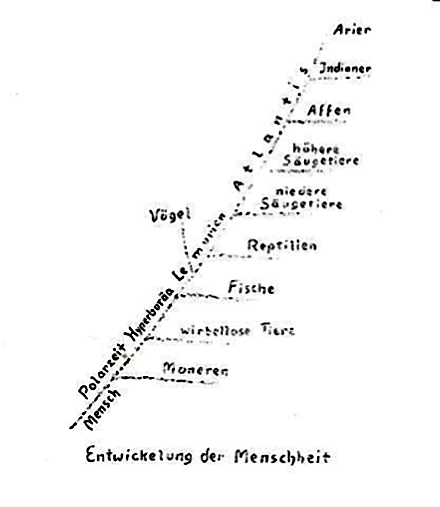
Steiner’s drawing of the “evolution of humankind” through the various stages – Hyperborea, Lemuria, Atlantis — from lower to higher forms (fish to reptiles to mammals etc), with the top three categories marked “apes,” then (American) “Indians,” then at the very top “Aryans.” Steiner’s 1907 lecture refers to both apes and Indians as “decadent side branches” of evolution.
Rudolf Steiner, 1907. Menschheitsentwickelung und Christus-Erkenntnis (Dornach: Rudolf Steiner Verlag, 1981)
Pervasive racial assumptions run throughout Rudolf Steiner’s work. Anthroposophy itself is : “built around a racial view of human nature arranged in a hierarchical framework,” and Steiner’s doctrine awards a higher or lower place in the spiritual evolution of mankind for certain races, with their attendant characteristics. If Freedman believes the schools can simply not teach what Steiner said, he shows a fundamental misunderstanding of the nature of Anthroposophy, and of its role within Steiner schools. Anthroposophy is not taught to the children: it informs the pedagogy. It is taught to the teachers. But since it is an esoteric religion, with hidden knowledge, that teaching is often opaque. In addition, Anthroposophy is not a tradition in which critical thinking is prized, indeed the intellectual is suspect; Steiner’s spiritual science has its own, privileged internal logic and route to acuity. As Olav Hammer, a Professor of the history of religions, comments in his accessible book ‘Claiming Knowledge’:
“..anthroposophy has an overtly formulated epistemology, which claims rational status for its visionary means of attaining knowledge.”
Hammer explains:
“For the anthroposophist, spiritual science is as inexorably logical as the natural sciences. The path towards attaining knowledge of the higher worlds, including insights into the exact mechanisms of reincarnation, lie open to those who practice the methods of Geisteswissenschaft [spiritual science] to the full. It is not only part of Steiner’s experience, but also potentially part of the experience of every individual. A carefully outlined series of meditative exercises describes how one can attain knowledge of the spiritual truths.”
and the system is itself insulated from critique:
“Steiner frees himself from the need for empirical investigation by claiming the ability to clairvoyantly access the Akashic record. In the Akashic record, Steiner found innumerable specific details on the workings of the cosmos and the human being, all presented as empirical facts.”
Hammer notes that Steiner’s method of spiritual science may appear democratic but is in reality autocratic. The only truly authentic insights are Steiner’s.
For those who believe they are developing clairvoyant faculties in pursuit of Anthroposophy’s Higher Worlds; Steiner’s racist doctrines, existing within an anthroposophical structure of reincarnation and karma, can be seen as essentially benevolent and redemptive. Though adherence (and awareness) certainly differs amongst teachers, it is impossible to remove Anthroposophy from the Steiner school pedagogy, from the required reading on the teacher training courses, from the mission of the schools. It would be entirely naive to imagine anthroposophical allegiances and beliefs in Steiner Free Schools could be policed by the DfE, especially as British courses disappear from public view or teachers are trained in other countries. Nor can the public be shielded from evidence of Anthroposophy’s precise nature and history.
Anthroposophy, and consequently the Steiner Waldorf movement, resist external critical analysis. The occult has until fairly recently been largely ignored by serious academics, and those who have explored Theosophy and other esoteric movements have been generally sympathetic to the possibility of supernatural agency. But, as we’ve seen with Olav Hammer as example, this has changed. There is now extensive academic research into the foundations of Anthroposophy and the development of Steiner Waldorf schools, enabling a non-arcane understanding of anthroposophical texts. Much of this is of course in German, including Helmut Zander’s 2007 two volume study, ‘Anthroposophie in Deutschland’.
Zander describes the ad hoc nature of the first Waldorf school, as Steiner borrowed much from already existing educational reform movements as well as from traditional models, and added his own spiritual insights. The results could only in some areas be thought of as progressive: the schools were co-educational and did not focus on exams. But from the beginning, the Waldorf system was teacher-led, not child-led and had strong authoritarian tendencies.

Rudolf Steiner 1861-1925 – Spiritual Insights
Most importantly, Zander contextualizes Steiner as a historical figure, without needing to pass judgements on the accuracy of his supernatural claims. He focuses on the political landscape in which Steiner existed in real, not occult terms. And he demonstrates the significant role of Steiner’s race theories within his work, noting how anthroposophical race doctrine frequently involves implicit or explicit value judgements. Even though Zander encourages dialogue with anthroposophists who can tolerate some kind of external analysis, an extreme voice still demanded Zander’s university revoke his degree, on the grounds that he couldn’t determine the validity of any of Steiner’s claims without himself attaining ‘knowledge of the higher worlds’. Crazy as this sounds, it’s the singular manifestation of a familiar anthroposophical motif, a demand that Anthroposophy be understood – and respected, exclusively on its own terms.
Rudolf Steiner and race: the path toward the universal human
One of the most authoritative writers about Anthroposophy in English is American historian Peter Staudenmaier. His recent PhD in modern history, written at Cornell, concerns Anthroposophy in Germany and Italy from 1900 to 1945. A fluent German speaker, Staudenmaier had access to Steiner’s untranslated work as well as to original archive material. He stresses that Steiner’s prolific output can be internally contradictory, enabling supporters to claim that anthroposophical race doctrine is incidental or misunderstood. But nevertheless, there’s a dominant and explicable theme, owing much to Steiner’s occult interpretation of German nationalism. Steiner’s attitude to Jewishness is an example of insular preoccupations:
“The nature of Steiner’s hostility to Jewishness was thus both ordinary and anomalous; it incorporated the common misconceptions of the era and simultaneously transcended these within the peculiar framework of “occult science”. It was not so much hatred or fear of Jews that animated Steiner’s mature antisemitism, but ignorance of contemporary Jewish life, of modern Jewish culture and history, as well as a myopic commitment to German spiritual superiority. What Steiner did know about Judaism, moreover, was generally refracted through a Christian and Germanocentric lens.” Peter Staudenmaier ‘Rudolf Steiner and the Jewish Question’ Leo Baeck Inst. Yearbook 2005
Steiner’s claims to ‘spiritual science’ to an extent reflect an earlier association with zoologist and social Darwinist Ernst Haeckel. (Richard Dawkins comments in ‘The Greatest Show on Earth’ that Haeckel was “perhaps Darwin’s most devoted disciple in Germany” and while praising Haeckel’s draughtsmanship adds: “the devotion was not reciprocated”.).
|
Staudenmaier suggests a mutable concept of evolution may have mediated Steiner’s shift from ‘secular to sacred’, but that it was a conversion to Mme Blavatsky’s occult movement, Theosophy, that most inspired Steiner’s racial theories:
|
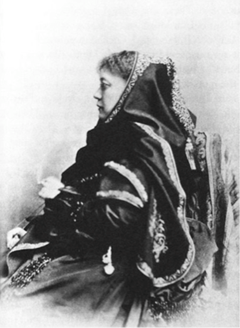 Madame Blavatsky: Theosophist and medium. |
“Steiner’s doctrine of racial evolution is more than a biological appendage to his spiritual cosmology. For Anthroposophy as for Theosophy, evolution is the link between the human and the divine, it is a process supervised by higher powers and a vehicle for the soul’s elevation and purification. [ ] The guiding thread throughout Steiner’s race mythology is the motif of a small, racially advanced group progressing into the next era while the great mass of backward populations declines. In the current era, the dominant race is the Aryan race, which evolved out of a small number of specially advanced colonists from Atlantis. In Steiner’s words: “Ever since the Atlantean Race began slowly to disappear, the great Aryan Race has been the dominant one on earth.”
There is a crucial difference for Steiner between ‘race development’ and ‘soul development’:
“The two must not be confused. A human soul can develop itself in such a way that it incarnates in a particular race within a given incarnation. If it acquires certain capacities in this incarnation, then in a later incarnation it can incarnate in a different race.”
Rudolf Steiner, Christus und die menschliche Seele [Christ and the human soul] (Dornach: Rudolf Steiner Verlag, 1997), 92
Staudenmaier elucidates:
“As the incarnating souls ‘became steadily better and better’, Steiner explained, ‘the souls eventually passed over into higher races, such that souls which had earlier been incarnated in completely subordinate races developed themselves upwards onto a higher level and were able to incarnate later into the physical descendants of the leading population of Europe’. Steiner further contended that the very existence of different racial groups on the Earth at the same time was a cosmic mistake, a detour from the proper route of humankind’s development. This claim was tied to Steiner’s vision of the eventual emergence of a ‘Universal Human’, the goal of his teleological conception of evolution. While pointing toward the ultimate disappearance of race as a meaningful factor in human existence, Steiner’s theory of the Universal Human is built around a contrast with ‘lower types of people,’ which constitute the necessary counterpart to the ‘uniform, perfect, beautiful type of human being,’ the cosmic goal that underlies ‘the meaning of our whole earthly evolution’.”
Though potentially spiritually ‘enlightened’ to the initiate, Steiner’s views on race remain reprehensible:
“The white population, then, represent normal human beings who continue to progress, while Asians and Africans are abnormal peoples who were not as capable of evolving. Statements like these can be found throughout Steiner’s works, and may reflect the prejudices prevalent among educated Europeans of his era. Perhaps the most instructive instances are Steiner’s various statements about black people. [ ] Addressing the first generation of Waldorf teachers in 1923, Steiner responded to a question about teaching French with the following remarks:
“The French are committing the terrible brutality of moving black people to Europe, but it works, in an even worse way, back on France. It has an enormous effect on the blood and the race and contributes considerably toward French decadence. The French as a race are reverting."
Peter Staudenmaier, Race and redemption: Racial and Ethnic Evolution in Rudolf Steiner’s Anthroposophy : Nova Religio 2008
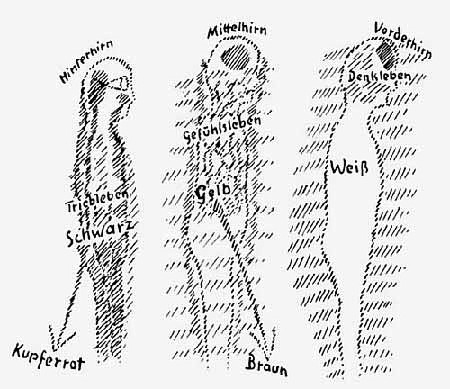
All must have disclaimers
Returning to the seminar in London discussing Free Schools funding for Steiner Waldorf: Should Steiner schools engineer a more multi-cultural image? This strategy would cause embarrassment to a government facing the understandable fury of non-white Steiner parents who come across Steiner’s race doctrines – unless Rachel Wolf persuades Cornell to revoke Dr Staudenmaier’s PhD (with assistance from dedicated anthroposophical defenders). Waldorf’s biggest problem, acknowledged after the departure of Freedman and Wolf, is undoubtedly the teachers:
“It was felt that there may be some difficulty in making a blanket rebuttal of all Anthroposophy because many people throughout the Steiner schools system, especially teachers, strongly support many aspects of that belief system. If teachers were asked to make a blanket rebuttal of Anthroposophy, many of them may not do this.”
They cannot do this. For many, Anthroposophy is the point. Rudolf Steiner is considered by his followers to be irreproachable, a spiritual master blessed with clairvoyant powers. Pull the thread of the race doctrines out of the design, there is a corresponding pressure on Steiner’s doctrine of reincarnation and karma. The Steiner Waldorf pedagogy itself rests on anthroposophical dogma. Although a reappraisal of doctrine is not without precedent within religious movements, it would be especially problematic for Anthroposophy, as an esoteric belief system. Knowing this, the easiest way to protect the movement is to be pragmatic and to issue disclaimers. But these disclaimers bear analysis, since many anthroposophists still defend Steiner’s racial and ethnic teachings; believing them, as Staudenmaier explains, to be “humanitarian, tolerant, and enlightened.”
Here is the (current) disclaimer on racism from the Steiner Waldorf Schools Fellowship (SWSF).
|
Is it true that some of Rudolf Steiners writings and lectures contained statements that could be interpreted as racist? Yes. Even though Steiner’s ideas are based on a profound respect for the equality, individuality and shared humanity of all people, regardless of race or ethnic origin, his works do contain a small number of quotations that are discriminatory. The SWSF rejects these statements and all racism. However, it should be noted that other great thinkers of his time including Darwin, Schweitzer, Gandhi and Carl Jung also spoke of race in a way that offends modern sensibilities. This does not render them or their work ‘racist’. It is ironic that Steiner schools sometimes have to defend themselves against these accusations. Our schools thrive on every continent, in every culture and within a wide range of ethnic contexts. For example, during the period of the apartheid regime in South Africa, the only school catering for mixed races was a Steiner Waldorf school & today there are schools following Steiner philosophy of education in diverse cultures & communities, including: Israel, Egypt, Kenya, Sierra Leone, Taiwan, Japan, Brazil or Hawaii, over 60 countries in all. It should be noted that all the Steiner schools in the UK actively are opposed to all forms of discrimination against any person or group of people on the grounds of race, gender, faith, disability, age and sexual orientation and are committed to promoting equality of opportunity and reflecting the diversity of the children, staff and parents served by their school. Further clarification about this can be found on the Statements page of the European Council for Steiner Waldorf Education website (by clicking the ‘Waldorf schools against discrimination’ link). |
The first word is unusual, though the disclaimer’s tone betrays the movement’s haughty antipathy to external analysis – and frankly it’s simply untrue. There are a very large number of Steiner’s pronouncements which could not only be interpreted as racist, they are racist. Saying they are not racist costs the SWSF nothing and will not make them disappear. (To be candid, many of Steiner’s statements clearly discriminate between races in both an unpleasant and prosaic manner, the ‘spiritual’ is no excuse.)
But the statement reveals a significant misunderstanding of racism. It is historically naive to imagine that being represented in diverse cultures and communities can define a worldview. Catholic schools are similarly represented, this doesn’t alter the nature of Catholic teachings; Anthroposophy’s racial doctrines do not magically change because there are Steiner Waldorf schools in Kenya. The disclaimer also ignores the fact that South African Waldorf schools were founded by Max Stibbe (the Waldorf school in Pretoria is still named after him), a vocal supporter of apartheid. Peter Staudenmaier comments:
“[Stibbe] was also the editor of the Dutch Waldorf journal Ostara, as well as the founding editor of an even more influential Waldorf journal, Vrije Opvoedkunst, in 1933. Vrije Opvoedkunst is where Stibbe published his racist articles in the 1960s, which formed the basis for the "racial ethnography" courses in Dutch Waldorf schools well into the 1990s.”
Nor can the recent promotion of a non-white titular Vice Principal (at the state funded 315 pupil (£5.2 million) Hereford Steiner Academy cancel out Steiner’s racial doctrines.
In addition, under “What is Anthroposophy?’ the SWSF states:
“Like many inspiring thinkers from the past, Ghandi and Darwin being other examples, Rudolf Steiner provides us with important insights which continue to be relevant today, as well as statements which conflict with our contemporary understanding of inclusivity and equality.”
It’s extraordinary that in a description of Anthroposophy by the Steiner Waldorf movement’s umbrella organisation in the UK, there’s no mention of karma, reincarnation, higher worlds, spiritual science etc, or the fact that anthroposophists believe Steiner was clairvoyant. Zoologists do not believe Darwin was clairvoyant – nor did Darwin teach an occult racial doctrine. Steiner’s unique status amongst his followers means that he cannot be excused as simply ‘a man of his time’. Even so, such racial ideas were rejected by many of Steiner’s contemporaries.
From a historical perspective, racial remarks should not be assessed according to whether they offend modern sensibilities. What makes a particular text racist is its content, what it actually says about race.

The 2nd Goetheanum, designed by Steiner – world centre for Anthroposophy – Dornach, Switzerland
The European Council for Steiner Waldorf Education) disclaimer document ‘Waldorf schools against discrimination’, linked to by the SWSF, states:
“Anthroposophy, upon which Waldorf education is founded, stands firmly against all forms of racism and nationalism. Throughout Steiner’s work there is a consistent anti-racist sentiment and he frequently described racist views as being anachronistic and antithetical to basic human values and dignity. The Waldorf schools are aware, however, that occasional phrases in Rudolf Steiner’s complete works are not in concordance with this fundamental direction and have a discriminatory effect.”
This is extraordinarily mendacious, and only sustainable if no one else – specifically no politician – reads any Steiner. The ‘discriminatory effect’ is reflected in the actions and decisions of teachers in the classroom, behaving in accordance with anthroposophical dogma which they may not even believe is racist. It should not be confused with an accusation that Steiner Waldorf schools openly discriminate on grounds of race, for example at point of entry, which they do not. Whether Steiner’s teachings themselves are ‘discriminatory’ makes little sense in an early twentieth century context – what matters is that they are racist. A confusion between discrimination and racism further highlights the worrying anthroposophist misunderstanding of racism.
This ECSWE disclaimer is cited by the Rudolf Steiner school South Devon. This is one of three English Steiner schools nearing funding, with the support of the Tory MP for Totnes, Dr Sarah Wollaston. The school also seeks to distance itself from “any racism stated or implied in any of Rudolf Steiner’s speeches and writings (dating from the mid -1880s to his death in 1925)” It’s alarming to find this on a school website bearing the name of the seer in question. But the disclaimer doesn’t acknowledge any statements by Steiner, much less examine their racial content. There’s no explanation of why this statement needs to be there.
On the same ECSWE site there’s a link to a document called: ‘Overcoming Racism through Anthroposophy: Rudolf Steiner and Questions of Race’. This is an audacious title. Peter Staudenmaier responds (hyperlinks mine):
“Far from a denunciation of any and all racist statements made by Steiner, it is a defense of Steiner’s racial teachings. It also claims that Steiner opposed antisemitism throughout his life, that he was deeply opposed to any philosophy of racial or ethnic superiority, and so forth. The document is co-authored by Detlef Hardorp and Lorenzo Ravagli, among others, who have very vocally and quite explicitly defended a range of Steiner’s racist arguments. This remains the mainstream position for both the Waldorf movement and the broader anthroposophist movement today.
In my view, a perfunctory ‘denunciation’ of ‘any and all racist statements made by Steiner’ — even if we could find such a denunciation from some anthroposophist body or other — would miss the point. If anthroposophists want to face up the racist components in their ideological legacy, they need to analyze and understand what Steiner taught about race, not pre-emptorily denounce it, and they need to figure out how to revise the overall conceptual structure of anthroposophy, which in its current form is built to a significant extent around racial premises. Simply waving away the problem with a vague gesture of disassociation accomplishes nothing toward that end, indeed it actively hinders the steps that could lead toward that end.”
A 1998 report by Dutch anthroposophists concluded there were no ‘racist teachings’ in Rudolf Steiner’s work. Peter Staudenmaier believes that an attempt by anthroposophists to come to terms with Steiner’s race doctrines, the “Frankfurt Memorandum” 2008, is flawed partly by using that Dutch report as its inspiration.
Significantly, former Waldorf teacher Tom Mellett notes parallels between the Steiner movement’s denunciation of Steiner’s racism and statements made by the Catholic church regarding priestly sex abuse.
Race in the classroom
Anthroposophy impacts on real children. Ray Pereira noticed the racist overtones in his child’s ‘Steiner stream’ in an Australian school:
“Mr Pereira, who is from Sri Lanka, said his concerns about Steiner’s racist beliefs were realised when his children were not allowed to use black or brown crayons because they were “not pure”. He said Steiner teachers at the state-run school recommended they not immunise their children because it would lead to the `‘bestialisation of humans”.”
Two years ago, at an established English Steiner school now applying for Free Schools funding; a British couple were alarmed when their 12 year old daughter (who’d been at the school for a year) told them a German teacher had read out the word ‘nigger’ from a book of poems, a standard text in Steiner schools. The mother reports that the teacher did not agree with the children that this is a racist word, indeed it was her daughter who was punished for refusing to back down. As a foster parent for many years and a mentor for Kids’ Company, the mother concerned is used to dealing with challenging situations but the school’s response to this incident (amongst others) shocked her. The staff seemed not to take the family’s concerns seriously and delayed taking action. Looking online for information on Steiner schools’ policies regarding racism, the mother discovered that in the book ‘How to Know Higher Worlds’, by Rudolf Steiner, (an edition last published 2008, Anthroposophic Press) a book on which one of the school trustees was basing workshops, there is an account of ‘reincarnation through the races’:
“Peoples and races are after all, merely different developmental stages in our evolution toward a pure humanity. The more perfectly that individual members of that race or people express the pure, ideal human type – the more they have worked their way through from the physical and mortal to the super sensible and immortal realm – the “higher” this race or nation is.”
In a formal meeting with the school, the father, who is black, calmly read aloud a quote from Steiner which stated that: ‘the black man is the child of the races’. There was no response from those present, presumably the trustees convinced themselves it was outside the remit of the discussion. The couple were shown the school’s discrimination document. But they report that when they asked the school’s Education Coordinator if he believed in Steiner’s doctrine of the reincarnation of the soul through racial hierarchies, he reddened with anger and refused to answer.
This critical Steiner mother notes an obvious inconsistency. In reply to a trustee’s defence that individuals chose which bits of Steiner to believe:
“I asked her, how they could do that when Steiner received his knowledge clairvoyantly – if it all came from the spirit world surely it was all true? I also said I didn’t believe that’s where he got his knowledge, unless the spirit world itself is racist.”
The child involved is now at school elsewhere. Her family arranged for a racism awareness day to be conducted at the Steiner school; this is required of every educational setting.

A Steiner Waldorf classroom (from here)
In response to Waldorf supporters’ claims that their teachers are simply not capable of racism and that Steiner schools are both enlightened and benign, Peter Staudenmaier writes:
“Many forms of racist belief are not intentionally sinister, but are instead embedded in high-minded, benevolent, and compassionate orientations toward the world. It is this type of racist thought, whose historical heritage extends through the White Man’s Burden and many forms of paternalistic racial ideology, that may find a welcome home in some Waldorf schools and other anthroposophical contexts, where it can perpetuate its ideas about race under the banner of spiritual growth and wisdom. This kind of racist thinking spreads more readily precisely because it is not tied to consciously sinister intentions. Seeing through this kind of racism – which, furthermore, often has more widespread and more insidious effects on the real lives of real people than the intentionally sinister variety does – means paying attention to the background beliefs that animate a project like Waldorf, whether among its founding generation or today.”
Staudenmaier is a historian, not primarily a critic of Steiner Waldorf education. But a knowledge of the history of the anthroposophical movement is essential if we are to make any sense of the difficulties the schools face today:
“I would be pleased if my research provided an opportunity for Waldorf admirers to ponder this contentious history and take its lessons seriously. What is worrisome about the Waldorf movement’s continued failure to address anthroposophy’s racial legacy is not that Waldorf schools in the twenty-first century will start churning out little Hitler youths; what is worrisome is that Waldorf advocates and sympathizers may unknowingly help prepare the ideological groundwork for another unforeseen shift in the broader cultural terrain, in which notions of racial and ethnic superiority and inferiority could once again take on a spiritual significance that lends itself all too easily to practical implementation in a changed social and political context. For this reason among others, I strongly encourage those involved in Waldorf endeavors to take another look at the history of their movement and the doctrines at its core.”
There is a reprise of these themes in an insightful article by novelist Hari Kunzru.
If those concerned with Steiner Waldorf education read nothing else, they should read Peter Staudenmaier’s article “Anthroposophy and Ecofascism”. It is a compelling account of Anthroposophy’s history; essential reading, too important to ignore.
Like Peter Staudenmaier, I have an interest in progressive forms of education. Steiner Waldorf education, far from being progressive or democratic, is dogmatic, autocratic and anti-intellectual. The persuasive lobby for state funded Steiner schools in my opinion misrepresents Anthroposophy, there are no exceptional applications. It is this lack of honesty that causes most concern. Steiner schools have failed a particular responsibility to their clients, not shared by Church of England or Catholic schools, to explain at the beginning what is for most parents an unfamiliar world-view.
Most seriously, mindful of Steiner’s dogma of karma and the reincarnation of the human soul through the races: If genuine equalities impact assessments were conducted on these schools, in my view it is inconceivable that the implications for children from black and ethnic minorities, and those with learning difficulties, would permit the funding of Steiner education.
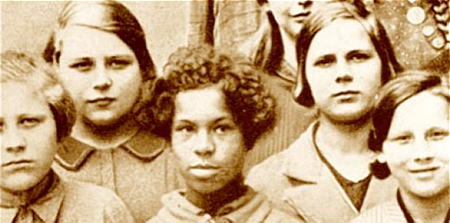
German children 1930s. Image from Black News Tribune
Postscript
Download a pdf file of Anthroposophy’s racial doctrines: explanation and examples by Dr Peter Staudenmaier.
Follow-up
This has been reposted from my old religion and education blog.
Derek Gillard’s excellent "Education in England" site had this beautiful piece. With his permission, I reproduce it here, because it has now vanished from his site. However you can still read also Gillard’s excellent essay “Creationism: bad science, bad religion, bad education”
Marcus Atkins, a classroom assistant at a Cornish secondary school, is taking the school’s governors to an industrial tribunal claiming unfair dismissal. He says the governors have discriminated against him because of his religious beliefs.
Atkins (pictured in class) is a member of the Fraternity of Neptune, a little known religious group which believes that, since life was created in the sea, they must honour the sea god by wearing full diving gear, including heavy metal helmet and lead-lined boots.
Governors at Porthnutnow High School decided to sack the classroom assistant on the basis that the children couldn’t hear what he was saying, that he refused to work in any classroom where children of fishing families were present, and that his lead-lined boots were wearing out the carpet in the school library.”
“Atkins says he has been unfairly treated. ‘The children can hear what I’m saying perfectly well,’ he told a BBC reporter. ‘All they have to do is stick the other end of my breathing tube in their ear and bingo.’ (At least, that’s what the reporter thinks he said).
Asked about the charge that he had refused to teach the children of fishing families, he replied ‘I’ve got to stick to my religious principles. Why can’t the head simply arrange the school’s timetable so that none of these children are in the classes I work with? What’s difficult about that?’
And the library carpet? ‘That’s ridiculous too,’ said Atkins. ‘I’ve refused to go in the library because there are books about trawlers in there, so how can I be wearing out the carpet?’
Atkins doesn’t have much support – hardly surprising given that Porthnutnow is a fishing village. His local MP is backing calls for him to be sacked and one government minister told the Sunday Mirror that the teaching assistant was ‘denying the right of children to a full education’.
Meanwhile, the government is pressing ahead with plans to open hundreds more religious schools, including a handful of academies sponsored by the Fraternity of Neptune. Grand Merman Sir Cyril Driftwood said ‘It’s a wonderful opportunity to teach children Neptunian theology, a subject I feel has been sadly lacking from the National Curriculum for too long.’
This item appeared originally on my old Religion and Education page. It has been moved here because of the discussion that followed my review in the BMJ of Unscientific America and the discussion that followed, on this blog and on P.Z. Myers Pharyngula blog.
Until recently, the idea that the earth was created 6000 years ago was largely restricted to right wing religious fundamentalists in the USA. Now we have a government in the UK which seems to be happy that such “fruit-cake” nonsense should be taught at the taxpayers’ expense.
The following article, Good God Almighty, was commissioned by Punch magazine, which folded before it could be published.
It refers to the fuss that followed the discovery that a state-funded school was being run by extreme ‘young earth’ creationists. If you want to see just how extreme, look at the speech made by Steven Layfield, the head of science at Emmanuel School. The views expressed are so extreme that the speech was actually deleted from the web site of the Christian Institute as soon as the fuss blew up. Luckily, thanks to the Google cache, this did not work and you can still read it at here.
Good God Almighty!
or Jurassic Theology
[This article was commissioned by Punch, but the magazine went out of business before it was published]
OK class, settle down. Here is your quiz. Compare and contrast the following.
(1) ” . . if the Bible really is the Word of God – and the internal evidence is overwhelming – true Science will always agree with it.”
(2)Science teachers should
“Note every occasion when an evolutionary/old-earth paradigm (millions or billions of years) is explicitly mentioned or implied by a text-book, examination question or visitor and courteously point out the fallibility of the statement and, wherever possible, give the alternative (always better) Biblical explanation of the same data”.
[Steven Layfield, Head of Science at Emmanuel School Gateshead, 2000]
(3) “There are those that argue that Science and Christianity can be harmoniously reconciled . . . We cannot subscribe to this view”
[John Burn & Nigel McQuoid; ex-head, and head, of Emmanuel School Gateshead, 2002]
(4) “Then there is science. Science is a God-given activity. Scientists are 5using their God-given minds and God-given creativity to explore and utilise God-given nature. Sadly, biblical literalism brings not only the bible but Christianity itself into disrepute.”
[The Bishop of Oxford. The Rt. Revd. Richard Harries, 2002]
(5) “God created the world and everything in it.” “It is about 6000 years old”
[Kate and Simon, pupils of Emmanuel School, Gateshead, interviewed by Mike Thomson, BBC]
(5) [Jenny Tonge, MP:] “Is the Prime Minister happy to allow the teaching of creationism alongside Darwin’s theory of evolution in state schools?”
[Tony Blair]. First I am very happy.”
“Secondly, I know that the honourable lady is referring to a school in the north-east, and I think that certain reports about what it has been teaching have been somewhat exaggerated”.
The prime minister is right. Something has been exaggerated:
The idea that teachers realise that the scientific method involves not declaring the outcome in advance.
Clearly, the head of science at Emmanuel doesn’t. To proclaim, before looking, that one view (the literal interpretation of the bible) is “always better” might be expected of an itinerant preacher in the deepest bible belt, but that is the view of the man in charge of educating children at a state-funded English school.
It is a view that offends the Bishop of Oxford, and it is contrary to the views expressed by Pope John Paul II. But don’t worry, our leader is “very happy” with it. To give equal time to a simple assertion (that the earth was created 6000 years ago), and to the wealth of hard-won reasons for thinking it to be untrue, is deeply offensive to every scientist who is trying to fumble towards the best approximation to the truth that can be found. Rarely can a couple of teachers and one prime minister have managed to offend so many people, everyone from bishops to professors, at a single sweep.
Of course neither the prime minister nor anybody else knows exactly what Emmanuel School has been teaching (though the reports from the children themselves give us a good idea). The glowing report from OFSTED was actually the result of a “short inspection” which does not look at such details. The school has not been given a full inspection since 1994, before the serious zealots took control. Views such as those in the first two quotations are so obviously relevant to the quality of science teaching that you may well ask how OFSTED managed not to notice that the views of the head of science were at the very extreme edge of fundamentalism.
Consider also the following amazing coincidence. The team of inspectors who found no fault with the unusual science (biblical is always best) teaching at Emmanuel was almost the same as the team that inspected the Huntington School, York. At that school they said that there was not enough teaching of religion (in the narrow sense, as opposed to spiritual values in general). The Huntington head teacher Chris Bridge lodged a complaint against that report, and it was partially upheld by OFSTED.
Does all this mean that extreme fundamentalism has infiltrated OFSTED, or does it simply mean that the inspectors did not do their homework?
The latter is the more charitable interpretation, but the inspectors are not going to get the chance to ‘try harder next time’. Instead Her Majesty’s Chief Inspector, wrote a letter to the chairman of the governors, asking for “clarification”. Unlike most schools, the Emmanuel School does not publish the names of its governors in the school prospectus, and neither OFSTED, nor the Department of Education, knows who they are. OFSTED does give the name of the chairman as “Dr `Peter Vardy” (as does the school if you phone). It turns out that the learned Dr Vardy is one and the same person as Sir Peter Vardy, the man who gave the government two million pounds to pay for the school. Don’t worry about the “Dr” bit though –it is perfectly genuine. The University of Sunderland was generous enough to give him an honorary doctorate in business administration (after he generously gave the University £1 million). The Chief Inspector (by then changed) recieved a suitably emollient letter from Sir Peter, but did no investigation whatsoever. Ofsted gives the firm impression of having born yesterday.
It is hard to appreciate the manic fervour of Mr Layfield’s notorious speech from only two quotations. It used to be on the web site of the Christian Institute (www.Christian.org.uk), and that site is still worth a visit. Mr McQuoid is a major contributor (see quotation no 2), but other bits are well worth reading too, like the vigorous defence of beating children (don’t get me wrong –I know there are lots of sites that deal with that sort of thing, but this is different; it is holy beating).
Mr Layfield’s speech suddenly vanished from this web site shortly after Tania Brannigan (of the Guardian) told us what was going on. Luckily, though, some kind folks thought it was such an outstanding piece of work that should still be available to everyone (just go to http://www.darwinwars.com/lunatic/liars/layfield.html).
Time’s up folks. Put down your pens and now go out and vote.
This item appeared originally on my old Religion and Education page. It has been moved here because of the discussion that followed my review in the BMJ of Unscientific America and the discussion that followed, on this blog and on P.Z. Myers Pharyngula blog. Evan Harris MP and I were up against the head of fundamentist school that had been started by wealthy used-car dealer, Peter Vardy. Being rather daunted by the Oxford Union, I actually wrote down my bit. The order of speaking because Evan Harris had to rush back to the House of Commons to vote against the Iraq war. The rest is history.
Oxford Union talk on ‘faith schools’ and creationism
This debate is meant to be about ‘faith schools’, but I suspect that the differences between the views of my two friends opposite are rather large. Mr Brady will, I presume, advocate schools that teach conventional religious views, and that I take to be the topic under discussion. First let’s get the issue of Mr McQuoid’s view on creation out of the way before coming to the serious matter of the debate. We have to be clear about one thing -there is a spectrum of religious views and Mr McQuoid is at the extreme fruit cake end of that spectrum. A true flat-earther.
An article by John Burn & Nigel McQuoid; (ex-head, and head, of Emmanuel School) stated:
“There are those that argue that Science and Christianity can be harmoniously reconciled . . . We cannot subscribe to this view”
This appeared on the web site of the Christian Institute, and that site is well worth a look. Apart from promoting ‘young-earth creationism’, it has two other obsessions, the evilness of homosexuality and the desirability of corporal punishment of small boys. It is truly bizarre. Well, at least Mr McQuoid’s job is not to teach science, but the head of science in his school, Steven Layfield, said in a speech published on the same web site (in 2000)
“…if the Bible really is the Word of God – and the internal evidence is overwhelming – true Science will always agree with it.”
Science teachers should… “Note every occasion when an evolutionary/old-earth paradigm (millions or billions of years) is explicitly mentioned or implied by a text-book, examination question or visitor and courteously point out the fallibility of the statement and, wherever possible, give the alternative (always better) Biblical explanation of the same data”.
He is free to express that view, but it disqualifies him from teaching science. The speech from which this is quoted, incidentally, disappeared form the web site of christian.org as soon as the row became public -one does wonder why, but don’t worry you can still ready it at the quaintly named site http://www.darwinwars.com/lunatic/liars/layfield.html However offensive it may be that such extremism is subsidised by taxpayers money, however offensive it may be that no full inspection of his school has been carried out since he came to power, and however offensive it may be that the prime minister supported his views, it is an irrelevant issue for the purposes of serious discussion. The pope does not believe that the earth was created 6000 years ago, the Anglican church does not believe that the earth was created 6000 years ago, hardly anyone but Mr. McQuoid thinks that the earth was created 6000 years ago (except in some parts of the south USA). The number of people who have that capacity to deny the obvious will never be more than handful, and to that extent we need not bother any further about them, and we can get on with the real issue of religious schools. As the Bishop of Oxford (The Rt. Revd. Richard Harries) said (2002)
“Then there is science. Science is a God-given activity. Scientists are using their God-given minds and God-given creativity to explore and utilise God-given nature. Sadly, biblical literalism brings not only the bible but Christianity itself into disrepute.”
Now to the real question…
What is wrong with allowing parents to choose a school for their child that teaches the parents’ religious belief? At first sight this sounds quite innocent, apart from the fact that it is the parents’ religious belief, not the child’s. In any case there are not many parents in the country who have religious (well Christian) beliefs. No more than 7.5 % now go to church regularly, and recently, for the first time, the proportion who profess even a nominal attachment to the church fell below half (as did the proportion of parents who have children baptised).
Why, then, are religious schools quite popular? The reason appears to be that they are selective. The rules say that selection must be on religious grounds only, but it simply does not work out like that. It is bad enough that children’s access to education should depend on their parents’ religious views (or, not infrequently, on their parents’ skill at lying about their religious views). But of course, selection of some implies exclusion of others, and, it turns out, not only because of their religion. Religious selection leads inevitably to racial selection too. In Oldham, scene of the recent race riots, the christian schools are almost exclusively white. Selection by wealth occurs too. In Accrington a C of E school has 12.5% of special needs pupils, while its neighbouring non-religious school has 69.8%; eligibility for free school meals is and 5% in the C of E school and 33% in its neighbour (on average the factor is almost 2).
How could such a disgraceful state of affairs come about? I believe that, as so often, a look at history might help, so let’s go back to see how the world looked in 1820.
Apart from 9 years I have spent all my working life at University College London.
The relevance of that will be obvious if we recall that in 1820, there were only two universities in England, Oxford and Cambridge (though 3 in Scotland). Both Oxford and Cambridge restricted entry to members of the Church of England – not only did they exclude Jews, atheists and muslims, but they also excluded many christians -catholics, protestants and dissenters. They would, no doubt, have excluded Mr McQuoid from getting higher education. It was in this context that liberals and dissenters in London founded the University of London, soon to become known as University College London, with the specific aim of admitting good students regardless of their religious beliefs, and with providing them with non-sectarian education in science as well as humanities (there was little science in Oxford and Cambridge at that time). Despite prolonged opposition from Oxford and Cambridge, UCL opened its doors in 1828.
At that time the fiercely conservative Duke of Wellington had just, albeit reluctantly, made the transition from general to prime minister. Even his government passed measures to increase the rights of catholics and dissenters, but his implacable opposition to electoral reform led to his resignation two years later, to be replaced by the Whig administration of Earl Grey.
The country was in ferment and change was rapid -in 1830 the Liverpool-Manchester railway opened and Faraday’s work on electricity was well-developed. But the electoral system was still mediaeval. The ‘rotten borough’ of Old Sarum (an iron age fort and 7 inhabitants) had two MPs while Manchester, already busy with the cotton trade, had none at all. In 1831 three attempts at electoral reform failed in parliament, but Earl Grey had told William IV “it is the spirit of the age which is triumphing and that to resist it is certain destruction”. The next year, in 1832, Lord John Russell (grandfather of Bertrand Russell) successfully got parliament to pass the (first) Reform Act and the modern age of democracy had begun.
The political ferment was paralleled by scientific ferment -people were no longer constrained by dogma and authority and new ideas came into medicine and biology too.
After another 40 years, Oxford and Cambridge caught up, when the Universities Test Act of 1870 eliminated religious criteria for university entrance. After 1870 it became quite unthinkable that a selection for higher education should be dependent on what a person believed, or did not believe in their private lives about religion.
That was 1870. Now it is 2002.. Can you imagine Oxford reintroducing religious selection of undergraduates now? Yet my friends opposite, and the government, are supporting a view of education that started to vanish in 1828 with the foundation of UCL, and finally died in 1870 with the Test Acts. They are trying to set back progress not by 10 or 20 years but by 175 years.
What next? Bring back rotten boroughs?

